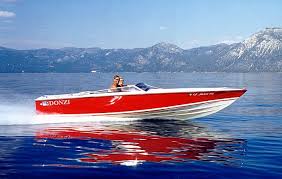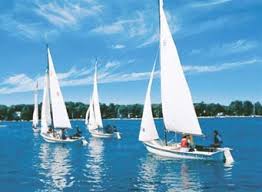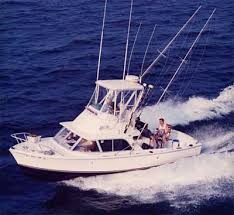skip to main |
skip to sidebar
 There are lots of articles written on choosing the right anchor and rode and the proper anchoring technique, but I seldom see any on how to deal with a crisis in an anchorage situation.
There are lots of articles written on choosing the right anchor and rode and the proper anchoring technique, but I seldom see any on how to deal with a crisis in an anchorage situation.
This is going to be a little different in that I will set a scene for a hypothetical story, but the viewers (YOU) need to add the final section based upon your own experience and training.
The story begins with a GB owner who clearly understands the basics of anchoring which are: (1) the right anchor for the anchorage and there is no one anchor that works in every situation, (2) an anchor needs to be properly set and tested by backing down hard, (3) sufficient size and length of rode is needed for all conditions even if it is dead calm and clear as a bell when the anchor is set.
Our captain also knows that if he cruises long enough, there will come a time when he needs an emergency plan if things really go to *beep* in a hurry. He doesn’t know it yet, but tonight is going to be that time.  The captain was one of the first boats to anchor and he selected what he considered the perfect location near the beach within easy dinghy reach and putting him in the lee of the prevailing easterly wind. After setting the anchor and tidying up the boat, he took the dog ashore and then came back to the boat, securely tied the dinghy, fixed a drink and relaxed on the flying bridge of his properly and well equipped GB admiring the scenery and watching other boats as they came into the anchorage. He also observed the anchoring technique of the other boats and made some mental notes as to which might find themselves in a bind if the wind were to change dramatically.
The captain was one of the first boats to anchor and he selected what he considered the perfect location near the beach within easy dinghy reach and putting him in the lee of the prevailing easterly wind. After setting the anchor and tidying up the boat, he took the dog ashore and then came back to the boat, securely tied the dinghy, fixed a drink and relaxed on the flying bridge of his properly and well equipped GB admiring the scenery and watching other boats as they came into the anchorage. He also observed the anchoring technique of the other boats and made some mental notes as to which might find themselves in a bind if the wind were to change dramatically.
At 2:00 a.m. the following morning he was awakened to the sound of thunder and went out on deck to check the weather. Altho no serious weather was predicted in yesterday’s forecast, it was obvious the weather was changing. The wind had shifted and increased. It had turned cloudy because no stars could be seen and he could smell rain in the air. However, it was too dark to determine the effect on all the boats in the anchorage because not all had anchor lights showing. Judging from the sound of the waves breaking on the beach he determined he had enough distance to let out some more anchor rode if needed. He set out his foul weather gear, set his alarm clock for 3:00 a.m. and went back to bed. The dog got in bed too.
 By 4:00 a.m. things were much worse. There were whitecaps in the anchorage and it was raining hard. The wind was at least 20 to 25 miles per hour with stronger gusts and the wind was right out of the west putting his boat off a windward shore. The crews on other boats were up and some working on their anchor lines. Others were getting spare anchors ready. Spreader lights were on and outboard engines were firing up. Based upon his observations of anchor lights, at least one boat appeared to be dragging; perhaps two and one was directly up wind of him. He also remembered this might have been one of the last boats to come in the anchorage and had not, in his estimation, tested their anchor holding sufficiently when they set it.
By 4:00 a.m. things were much worse. There were whitecaps in the anchorage and it was raining hard. The wind was at least 20 to 25 miles per hour with stronger gusts and the wind was right out of the west putting his boat off a windward shore. The crews on other boats were up and some working on their anchor lines. Others were getting spare anchors ready. Spreader lights were on and outboard engines were firing up. Based upon his observations of anchor lights, at least one boat appeared to be dragging; perhaps two and one was directly up wind of him. He also remembered this might have been one of the last boats to come in the anchorage and had not, in his estimation, tested their anchor holding sufficiently when they set it.
While I share the concern for safe drinking water, I believe it can be misleading to think that by merely adding bleach to the tank water, you can have "safe" drinking water.
There are several reasons for this, including, drinking bleach is not healthy. We have been drinking "bottled" water for many years to avoid the chlorine bleach and flouride additives to our public drinking water, both of which are toxic within our bodies.
Another reason is that merely adding bleach does not guarantee that all pathogens are "killed" that exist in much of our public drinking waters. I'm sure many of you have read about the "outbreaks" of health problems associated with public drinking water from time to time, even though it has been bleached and flourided.
Another reason is that the tank water in our GBs may (most do) contain very toxic amounts of lead and/or other metals. The reasons for this are that the solder used to manufacture the tanks normally has high lead content and the fact that tank water stays in contact with the metals used to make the tank for long periods of time and therefore absorb more toxins. Keep in mind that chlorine bleach also attacks stainless steel and will pit it. This means that certain portions of the metal alloy is being disolved by the "water". This is not good for the tanks nor for our bodies. Most commercial operations use an iodine solution to sterilize SS, not bleach.
Years ago, being suspicious of this problem, we had the water tested from our tanks and the laboratory results showed very high concentrations of lead. We have not drank tank water ever since, choosing to drink the water from our watermaker instead, even using the water from our watermaker at home instead of bottled water. This also has the added advantage of running the watermaker more frequently thereby avoiding the need to "pickle" the membranes.
There are various ways to minimize the potential problems of drinking tank water involving filtration and/or UV sterilization, or as we do, simply avoiding it all together.
I suggest you define what goals you are attempting to reach and then do the research to achieve them. I doubt that adding bleach to your drinking water will provide "safe" drinking water.
My wife and I traveled the Great Loop aboard a 50ft Trawler with a freeboard over 5 ft. Many of the freshwater docks are floating and therefore well beyond her reach and there was no quick way to get off the boat and on the dock safely. The best way to handle a docking situation like that is for me, the Captain, to get the boat where it is supposed to be and not expect her to be a magician with the lines and bail me out of some nightmare I had gotten us into by a bad docking maneuver. I wish I could say that never happened! However, the goal of achieving that was always there. She did however become somewhat proficent at lassoing the dock cleats. Although no two docking situations are ever the same, most should be at least somewhat predictable and with time you may even find it to become almost automatic. Having said all that we found that our move from a trailerable 26 ft cruiser to a 24 ton Trawler to be quite intimidating and had many questions as to how we would manage as well. Our decision was to pay Chapmans Boating school, located in Stuart Fl., for a 1 week private instruction aboard a boat similar in size to the one we expected to buy. They will even do it aboard your boat as well. One of the things we requested to be covered was docking for us both. (my wife had seldom been behind the wheel of anything larger than a ski boat)Our instructor (Captain) drilled us both with hundreds of dockings. The experience was invaluable! The price of the course was acceptable when balanced against the cost of our trawler.
While there have been previous posts on this topic, they are pretty outdated, given the advancements of technology, price, etc.
I am considering the purchase of a new set of binocs. The prices are still daunting but better than four years ago.
What is the advice for the good of the order between, for example, the Canon 12x36 vs the Canon 15x50? Or is the Fujinon still the top dog in this category? Of what importance is field of view vs. price for a decent marine binoc? The reports on the big Canons talk about their application for astronomy. But the price differential between the two models is huge. Is that advantage in precision really important for nautical use in such tasks as identifying buoys? I currently use a 12 year old Fuji 7x50 which is great, but, of course, not stabilized.
Having spent many years in the south and tropics I have been a keen observer of hurricanes and what you can or cannot do to protect your boat. As a former surveyor I have also witnessed first hand the aftermath of the destruction hurricanes cause to boats. I’ve learned a few things and my Lesson Learned #1 is that no boat is worth losing your life over, so I would never stay on board during a hurricane. Lesson #2 is that there is no guaranteed safe place for a boat in a serious hurricane. Lesson #3 is that a boat has a better chance of survival out of the water than in it, but Lesson #2 still applies.
The force of wind is directly proportional to it velocity, but cubed. In others words, if the wind speed increases from 50 MPH to 100 MPH the force increases by a factor of 8. The surface area of the boat is not linear either. If Boat A has twice the surface area of Boat B, the factor is squared and the effect on A will be 4 times greater than on B. Therefore, someone who stayed on their 38’ Express cruiser in a 70 MPH wind and survived doesn’t mean anything for someone with a 42' Trawler in a 140 MPH wind.
At some point during a serious hurricane anyone who stays on board will lose control of his or her ability to survive (it is pure luck after this point). Debris becomes airborne and begins to attack like missiles. I inspected a GB several years ago that had been hit with a flying deck chair that had smashed in a cabin window which in itself would have been repairable, but the damage from the torrential rains that poured into the cabin was beyond imagination. The boat yard estimated $30,000 of damage, but I would have said a minimum of $100,000 and the boat would still never be restored to its original condition. As a follow up to this story, it was reported that the owner of the boat whose deck chair did the damage (he did not know of it at the time) was asked if his boat had suffered any damage and replied, “Oh, I lost a couple of deck chairs – no big deal”. The point of my story is that you can do everything possible to hurricane-proof your boat, but you can’t keep the other boat owners from being negligent. Years ago when Hurricane Hugo blew thru the Caribbean everyone ran to the hurricane holes of Culebra for protection and those who got there first put out multiple anchors and secured their boats to perfection as they hunkered down in the most secure parts of the anchorages only to watch with horror as those last to arrive simply threw out an anchor, jumped in the dinghy and went to shore. These lightly anchored boats of course broke lose and pulled out the anchors of those to leeward until there became a wall of entangled boats marching in a giant line engulfing all in its path. Nine who stayed on board died.
In winds over 100 MPH (still only Category 2) you have to crawl along the deck to get to the bow. The anchor rode will be like a steel bar and the rain will sting your face so hard you cannot open your eyes or face into the wind. Storm surge in a Cat. 3 hurricane is 9 to 12 feet in addition to the tide. Most marina docks will be under water and those that float will probably be off their pilings. Your boat may be well secured, but will all the others? It only takes one loose cannon to cause extensive damage which multiplies as more are broken loose. Marina personnel will typically be home trying to protect their own properly or have fled the area. Many marinas are in a mandatory evacuation zone and no one will be permitted into the area. And don’t forget that some boat owners want to lose their boat in a storm because the insurance is greater than its market value.
In preparation remove every item you can (canvas, Bimini, dinghy, OB Motor, taff rail covers, etc. and lower the mast or remove it). Fenders are needed on all sides and as many as you can find. It helps to tie them in such a way that they cannot roll up the side of the boat by running lines under the bottom of the boat. If you have rigid window covers (aluminum, plywood, Lexan) install them. Marinas will turn off the power to the dock so don’t plan on having shore power for battery charging, air conditioning and refrigeration. Boats that are hauled out and put on jack stands should have the stands chained together athwartship and the hull secured to embedded ground anchors. Boats tied along side docks are at greater risk, but those tied between wood pilings (if they are tall enough) will often fair pretty well due to the flexibility of the pilings. Concrete pilings are terribly un-friendly to boats.


